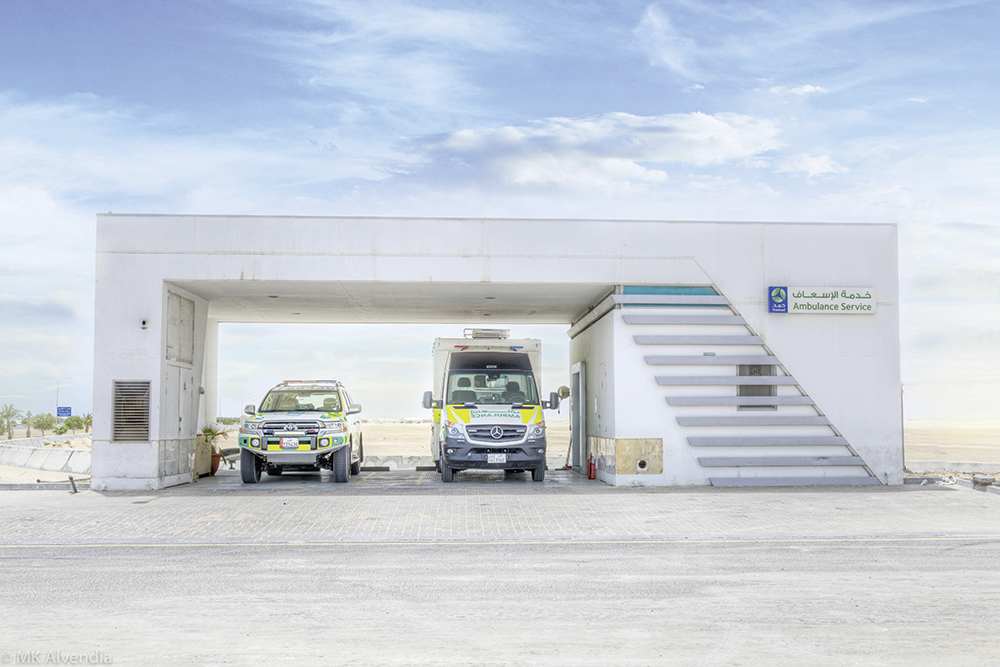

Letting out the pressure while having fun in the desert: First let a little air out of the tyres, then put your foot down and head out into the desert, up and down the dunes at breakneck speed – “dune bashing” is a popular sport for men in Qatar. Small armies of Qataris charge through the desert, particularly on Fridays (the Islamic Sunday) with quads, buggies, off-roaders and SUVs, with the desert terrain near the capital, Doha, or the dunes near the Saudi Arabian border in Chour al-being particularly popular locations for thrill seekers with a need for speed. No one cares about the high fuel consumption when a litre of petrol only costs 20 cents. Qataris hold two world records: the highest CO2 emissions per capita, and the highest per capita income.
For watching visitors from Germany, the rush through the desert is both different and spectacular. It is always astonishing to see how steep the slopes are that SUVs like Toyota Land Cruisers, Nissan Pathfinders and Mercedes GLs can conquer, and how hard these luxury vehicles are thrashed by their proud owners. The wheels whip up thick clouds of dust that make it hard to see when driving: no one can really tell, in the midst of all this sand, whether there’s another vehicle rushing across the dune from the other side. The desert camps are brightly lit at night, but just a few hundred metres away, the light is swallowed up by the desert, so the drivers navigate by starlight – making them hard to find when an accident occurs.

In a country that largely consists of desert, it’s no surprise that the favourite leisure activity of the (male) population reflects the country’s geography. However, when horseplay and horsepower come together, accidents are par for the course, not to mention the many tourists who have worked out that, once you reach a certain speed, loose sand becomes as hard as concrete. It’s a good thing, therefore, that the Qatari emergency services are prepared desert operations: a dense network of “hubs and spokes” made up of bases for rescue teams and their emergency vehicles keep the routes to access the popular desert camps as short as possible. Using a system of response vehicles made up from Alpha, Charlie, and Delta units, the HMC (Hamad Medical Corporation) operates a range of vehicles adapted for different landscapes and surfaces on behalf of the State Ambulance Service. Alpha Units are standard on-road ambulances, while Charlie and Delta units are 4×4 first responders with different crews that are comparable to our paramedic units. Charlie units have a critical care practitioner (CCP) and an ambulance practitioner, while “distribution supervisors” travel alone in Delta units to manage the scene of the accident. As well as these vehicles, a helicopter squadron is deployed, as a bird’s eye view means that accident scenes can be identified, and vehicles sent to the incident, particularly quickly.
To ensure even more effective medical treatment, the ambulance system was expanded in 2017, via a close collaboration between WAS and HMC, with two completely new vehicles. WAS developed a uniquely flexible vehicular transport concept for new PTS (Patient Transport Service) units to transport patients quickly and safely, while the new “Rural Ambulance” offers particularly comfortable, comprehensive treatment for extended journeys to hospital.
This WAS 4x4 PTS vehicle, based on a Mercedes-Benz Sprinter long-wheelbase van, allows patients to be transported in a wheelchair, lying on a stretcher, or even as a heavy load. It’s even possible to transport two patients (one lying down and one in a seated position) with their treating clinicians, or even as a heavy load. The concept impressed HMC with its high degree of flexibility, and was even presented in Qatar by the Health Minister, HE Dr Hanan Mohamed al-Kuwari. These vehicles are complemented by “rural” ambulances, which collect patients from the edges of the desert and transport them to the hospitals. These fully-equipped box vehicles, based on a Mercedes-Benz Sprinter chassis, do not travel to the accident scene in the desert: instead, they handle “overland” transportation to the nearest hospital. As they are better equipped than the off-road capable Charlie Units, they pick up the patients as soon as possible. To ensure better visibility for helicopter pilots, they have roof-mounted, flashing LEDs in addition to the usual side-mounted lights. The vehicles’ insulation and air conditioning are also adapted for use in Qatar, where temperatures can exceed 40 °C even in the autumn, while a new layout allows two patients to be transported horizontally at once.
This combination of different vehicle types, including helicopters, allows accident victims to be rescued from the desert in a rapid, safe, and comfortable manner. As each vehicle is specially adapted to operate on its own terrain, valuable time is saved when handing patients over from transportation to the treatment unit. This dual-phase rescue operation, while not exactly making dune bashing safe, should at least mitigate some of its consequences. As an aside, the rescue service (just like water and electricity) is only free of charge for Qatari citizens – so tourists should drive doubly carefully!

This text was first published in the WAS customer magazine „Safety First“. You can request a free copy of this and many other interesting topics by sending an e-mail to marketing@was-vehicles.com.





